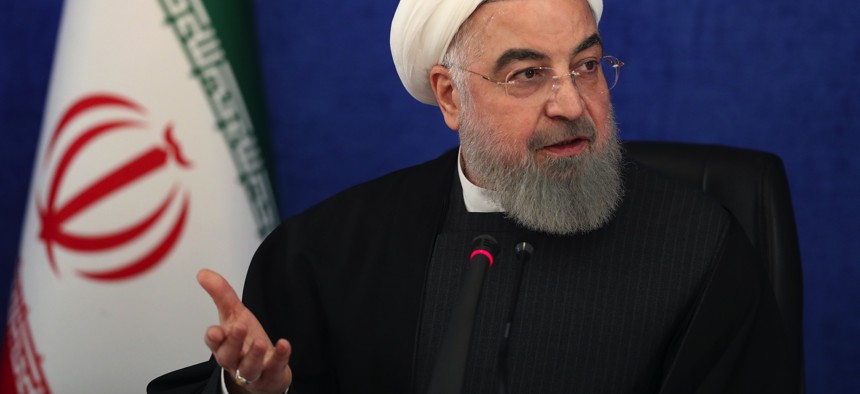
Iranian President Hassan Rouhani speaks during the National Combat Board Meeting with Coronavirus (COVID-19) in Tehran on January 9, 2021. Iranian Presidency/Handout/Anadolu Agency via Getty Images
Iran Will Still be a Slog
We can expect Tehran to use three tactics to seek advantage in negotiations.
Even if the logic of the Trump administration’s policy toward Iran were sound, it didn’t work. Amid what the administration hailed as a “maximum pressure” campaign, Iran summoned its own maximum resistance strategy. The Iranian government remained in power, it began enriching large amounts of uranium to much higher concentrations, it continued to develop long-range missiles, and it increased its involvement in the politics of surrounding states.
While the Biden administration has committed to pursuing a different policy, it may not be able to achieve different outcomes. The more the administration pursues the Iranians, the more the Iranians will pull back, in a bid to increase their leverage. Yet, the more the United States pulls back, the more the Iranians will try to force the United States to engage. We should not expect an easy return to negotiations, whatever the Biden team wants, and we should not anticipate that a supposedly wounded Iran will capitulate. Instead, we should anticipate a drawn-out process punctuated by crisis. There probably isn’t a better path forward.
While Americans often seem to forget, the U.S.-Iranian conflict is one of vastly unequal parties. Iran’s GDP is about equivalent to the state of Maryland. Its air force relies heavily on warplanes purchased from the United States before the 1979 revolution. The country has no close allies. It is something of a wonder Iran is even tempted to go toe-to-toe with the United States.
Convinced that it is locked in an existential battle, the Iranian government pulls out all the stops. Its playbook at this point is fairly clear, and it has three principal elements.
The first element is to insist at every opportunity that the disparity in national power isn’t nearly as large as it is. The Iranian government is convinced that showing weakness is a fatal mistake, and its determination to show strength often pushes it to overplay its hand. Recall that when President Donald Trump called President Hassan Rouhani at the UN General Assembly in 2019, Rouhani wouldn’t come out of his room to take the call.
The second principle is to use time as leverage. During negotiations with the Obama administration, Iranians demonstrated no hurry to conclude. After all, its senior officials had no more important task than negotiating with the United States. U.S. senior officials, though, had myriad other responsibilities. The United States was trying to manage the world, but Iran was focused principally on managing the United States.
The third principle is to create urgency among negotiating counterparts, to reinforce the conclusion that Tehran is more dangerous when it is isolated than when it is engaged. One way Iran does this is through actions that are difficult to attribute, at least immediately, and therefore more difficult to respond to. These include cyber attacks, the attack on Gulf shipping in the summer of 2019 and the attack on Saudi oil facilities in September 2019. Iran also uses aligned groups, such as the Houthis in Yemen and Hezbollah in Lebanon, which it supports but which it claims it does not control, but whose actions often advance Iranian goals.
Tehran also creates urgency by advancing its nuclear program. Iran’s announcement earlier this month that it had begun to produce highly enriched uranium for the first time since the 2015 nuclear agreement, the Joint Comprehensive Plan of Action, was a recent example of this. More broadly, though, the entire Iranian nuclear program sometimes seems to serve as an instrument to regulate diplomatic tensions rather than as a scientific endeavor.
Underlying all three principles appears to be an Iranian conclusion that conflict with much of the world is inevitable. That conflict needs to be regulated and managed, but it cannot be resolved.
There is impatience among many U.S. allies and partners to return to the 2015 nuclear deal, and great fear among others – especially Iran’s neighbors – that returning to the agreement would endanger them. Yet, seeing negotiations with Iran in terms of the JCPOA is a mistake. The agreement had sufficient defects, both in terms of its rapidly approaching sunset provisions and its blind spots over enforcement, that there is no easy return. Instead, what is on offer is a long and difficult set of negotiations.
Iran is unlikely to conclude a broad agreement before its June 2021 presidential elections, which will almost certainly produce a leader far more skeptical of negotiations than outgoing President Hassan Rouhani. In the interim, Iranians will fight to position themselves for the forthcoming negotiations, using all three strategies noted above.
The Biden team has plenty of experience with the Iranians, and its expectations are likely clear. There will be an Iran deal, and then another Iran deal, but they are unlikely to be able to strike “the” Iran deal that eliminates threats from Iran once and for all. Iranian strategy just won’t accommodate that sort of agreement. The Iranians are embarking on a process of negotiations, not finding a solution. The U.S. public is still hoping for a solution. Insisting on one plays into the Iranians’ hands.


